How to Use ChatGPT for Marketing – Learn From 7 Practical Examples
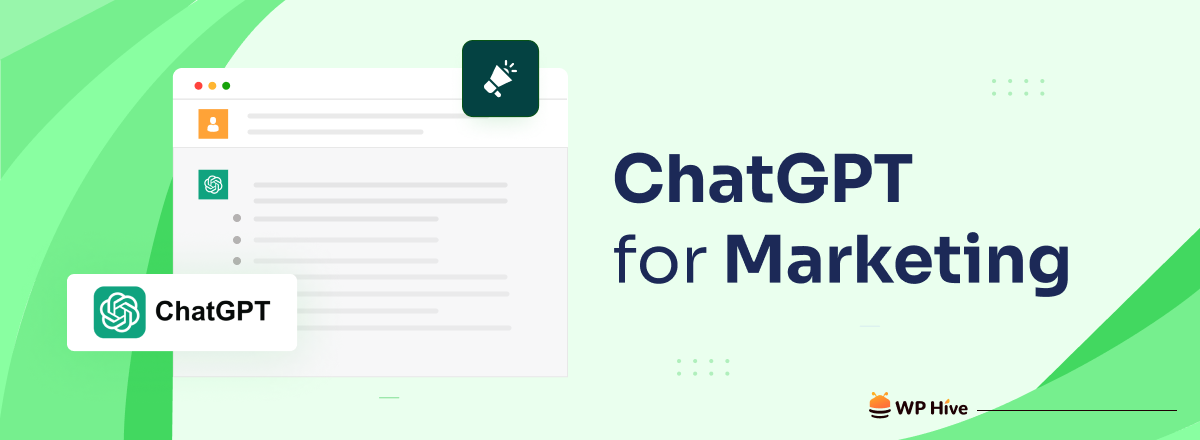
ChatGPT is a gold mine for marketers – only when you can turn it into a place where AI and creativity join forces to supercharge your marketing efforts.
In today’s fast-changing digital world, connecting your audience meaningfully is key. And, ChatGPT can be your trusted partner to help you achieve that. It can assist you in creating captivating advertisements, optimizing SEO strategies, writing high-converting emails, engaging your social media followers, and more.
Whether you’re an expert marketer or just starting in the field, ChatGPT is here to help you utilize the power of AI to take your marketing initiatives to new heights. This post will guide you on how to use ChatGPT for marketing. Let’s dive in and discover the limitless possibilities that ChatGPT has to offer.
Quick Navigation
A brief history of ChatGPT: How it evolved from scratch
ChatGPT represents a significant milestone in the development of conversational AI. It emerged from the lineage of GPT (Generative Pre-trained Transformer) models, which were pioneered by OpenAI. The GPT series began with GPT-1 in 2018. Since then, it’s been evolving each day.
GPT-2 gained wide attention due to concerns about its potential misuse, leading to its initial restricted release. This concern was based on fears that the model’s remarkable text generation capabilities could be exploited for spreading misinformation or generating malicious content.
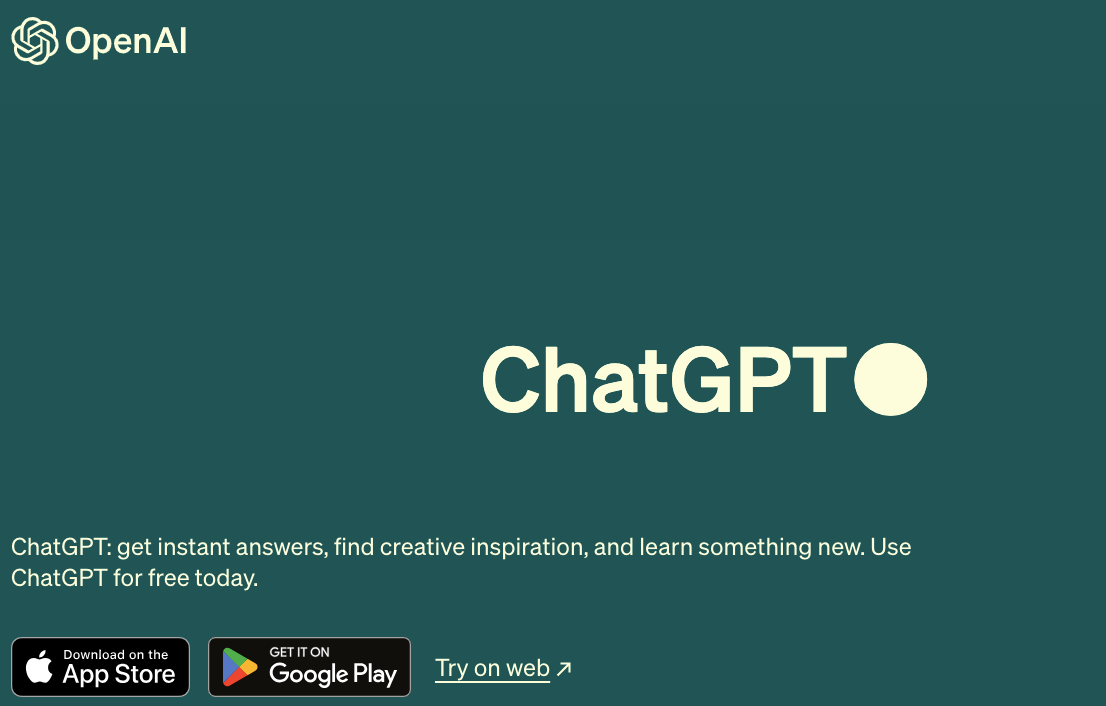
After a few iterations, GPT-3 came into play and demonstrated unprecedented natural language understanding and generation advancements. ChatGPT specifically emerged as a product of OpenAI’s exploration into fine-tuning GPT-3 for various conversational tasks.
ChatGPT achieves a milestone, attracting more than 100 million users within just two months of its launch.
The Guardian
It was initially released in a research preview to gather user feedback and assess its real-world applications. Here is a brief history of ChatGPT:
- June 16, 2016: OpenAI published groundbreaking research on generative models, laying the foundation for ChatGPT. These models were trained to create data like images, sentences, or sounds.
- September 19, 2019: OpenAI improved the GPT-2 language model by considering human feedback.
- January 27, 2022: OpenAI introduced InstructGPT models, related to ChatGPT. These models got better at following instructions, reducing false information, and avoiding harmful outputs.
- November 30, 2022: OpenAI officially launched ChatGPT using GPT-3.5. This was the free version that democratized AI for everyone around the globe.
- February 1, 2023: OpenAI introduced ChatGPT Plus, a premium subscription with less downtime and new features.
- March 1, 2023: OpenAI released the ChatGPT API to enable developers to use ChatGPT in their applications.
- March 23, 2023: OpenAI added ChatGPT plugin support with features like Browsing and Code Interpreter, making it more versatile.
The future of ChatGPT remains uncertain and depends on factors such as government regulation, legal challenges, competition, and evolving technology trends. But, the recent growth is talking in favor of ChatGPT’s bright future.
How does ChatGPT work?
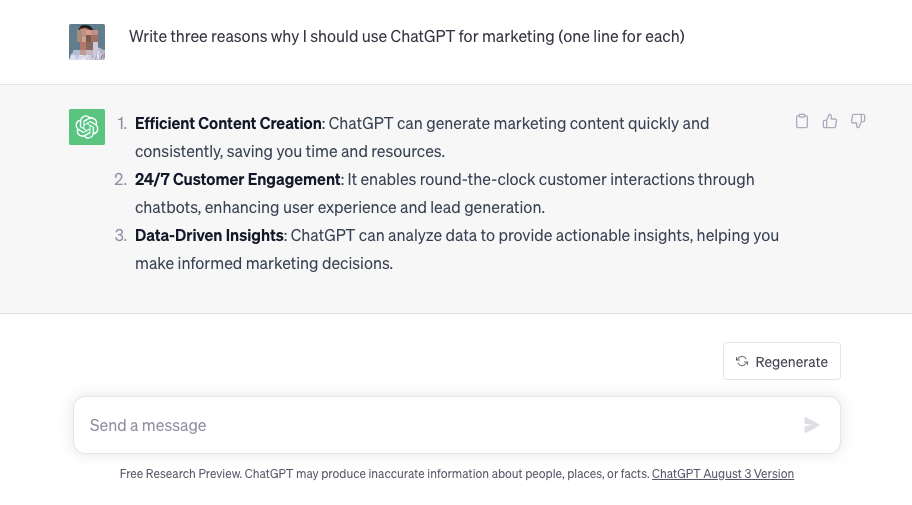
To use ChatGPT, you send it a prompt or a series of messages, and it generates a text-based response. The model relies on patterns in the data it was trained on to create coherent and contextually relevant responses. It does not possess true comprehension or consciousness but simulates understanding through pattern recognition.
ChatGPT works by utilizing a machine learning technique known as deep learning. Specifically, it uses a type of neural network called a transformer model. Here’s how ChatGPT works:
- Training with large amounts of text: ChatGPT is trained on vast amounts of text data from the internet. This training corpus includes publicly available information, licensed data, and contributions from users and human trainers.
- Understanding and predicting language: During the training process, ChatGPT learns to predict the likelihood of the next word in a sentence based on the words that came before it. It learns grammar, syntax, and semantics, allowing it to understand and generate human-like text.
- Weights and parameters: The model is comprised of a large number of parameters or weights that represent its knowledge. The changes in these parameters reflect the model’s increasing understanding of language.
- Contextual responses: When you interact with ChatGPT by asking a question or giving it a prompt, it uses its learned knowledge to generate a response. It considers the context provided in the prompt and uses its understanding of language to generate a coherent and contextually relevant reply.
- Variability in responses: ChatGPT doesn’t produce the same response for the same input every time. There is an element of randomness in its responses, which can lead to slightly different answers for similar questions.
- Privacy considerations: OpenAI takes privacy seriously in the development of ChatGPT. While some of the training data may contain personal information, the model is not designed to actively seek out or use personal data.
- Compliance with privacy laws: OpenAI complies with privacy laws such as GDPR and takes steps to protect personal information used in training. Users have rights to object, access, correct, restrict, delete, or transfer their personal information included in the training data.
As a marketer, you don’t need to understand the mechanism of ChatGPT fully. All you need to know is how to use this tool to its fullest potential. The following section will help you learn how to use ChatGPT prompts for various marketing purposes.
How to use ChatGPT prompts for marketing

Using ChatGPT prompts for marketing requires a thoughtful approach that combines the efficiency of AI with the creativity and strategic thinking of human marketers. At first, you need to define your marketing objectives, identify your target audience, and determine where AI-generated content can be most beneficial in your marketing strategy. Common use cases include blog post ideas, social media updates, email subject lines, product descriptions, and more.
Then it’s your turn to learn how to craft effective prompts. Keep reading to unfold the secrets of ChatGPT prompt engineering.
1. Craft clear and specific prompts
Craft clear and specific prompts that instruct ChatGPT on the type of content you need. If necessary, include context and brand guidelines in your prompts to ensure that the generated content aligns with your brand’s tone, style, and messaging. Here are some tips on how to do it effectively
- Be explicit about the content type.
- Provide context when needed.
- Include relevant keywords.
- Set clear guidelines or restrictions.
- Use examples to illustrate your expectations.
- Keep instructions concise.
- Set the right tone.
- Be prepared to iterate and revise prompts for desired results.
For example, a generic prompt may look like “Write a sales copy to sell black coffee”. But, this will generate poor results. Instead, you can write this prompt in the following way:
Write a 100-word sales copy to convince black coffee lovers to buy my product named Blackafe. Include the keyword ‘best black coffee brand’. Follow the AIDA model to make it more compelling to the buyers. Use emojis to make it look more exciting.
Now look at the amazing result ChatGPT produced in the below image:
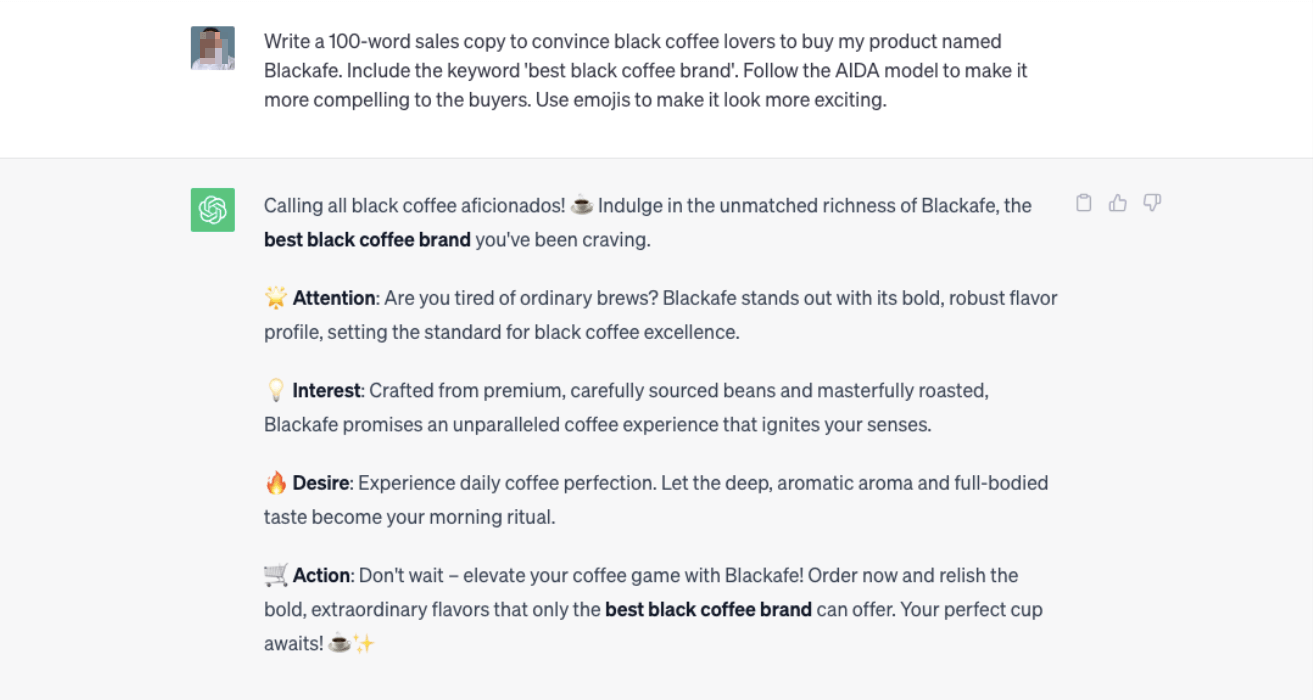
Yes, the output of the prompt is quite good. Still, you need to edit the copy to make it sound humane. And, don’t forget to refine your prompts until you get the desired results. Tweak the prompts each time to improve the copy.
2. Take inspiration from our examples
You can use ChatGPT for a wide range of marketing needs. It offers versatility in content creation. Some of the common types of marketing content that ChatGPT can assist you with include:
| Marketing content types | Marketing content types |
|---|---|
| Content outlines and blog posts | Case studies |
| Social media post | User reviews and testimonials |
| Email subject lines and copies | Presentation slides |
| Product descriptions | Title ideas |
| Press releases | Website copies |
| Ad copies | Newsletters |
| SEO metadata | Content ideas |
| Video scripts | Brochure content |
| Whitepapers and eBooks | Landing page copies |
| FAQs and knowledge base articles | Taglines and slogans |
No matter what type of marketing content you prepare using ChatGPT, proper prompt engineering is necessary for optimal outputs. Let’s learn with us how you can use ChatGPT to its fullest potential with our exclusive prompts. We will show you the five most used cases where ChatGPT can do wonders for you.
a. How to write product descriptions
Crafting an effective prompt for generating product descriptions with ChatGPT requires precision and clarity. Begin by clearly identifying the product you want a description for. List the essential features and attributes of the product that you want to emphasize in the description. Include details such as size, color, materials, and functionalities.
Here’s an example of a well-crafted prompt for a product description:
Generate a product description for our new ‘Premium Stainless Steel Travel Mug.’ This travel mug is designed for outdoor enthusiasts and coffee lovers who demand durability and style.
Highlight its 20-ounce capacity, vacuum insulation, and leak-proof lid. Use a casual yet informative tone, aiming for around 100 words. Include keywords ‘travel mug’ and ‘stainless steel.’ Emphasize its ideal use during hiking, camping, or daily commuting.
Include the features in 7 bullet points. Add a convincing CTA at the end.
And here’s the output that can blow your mind:
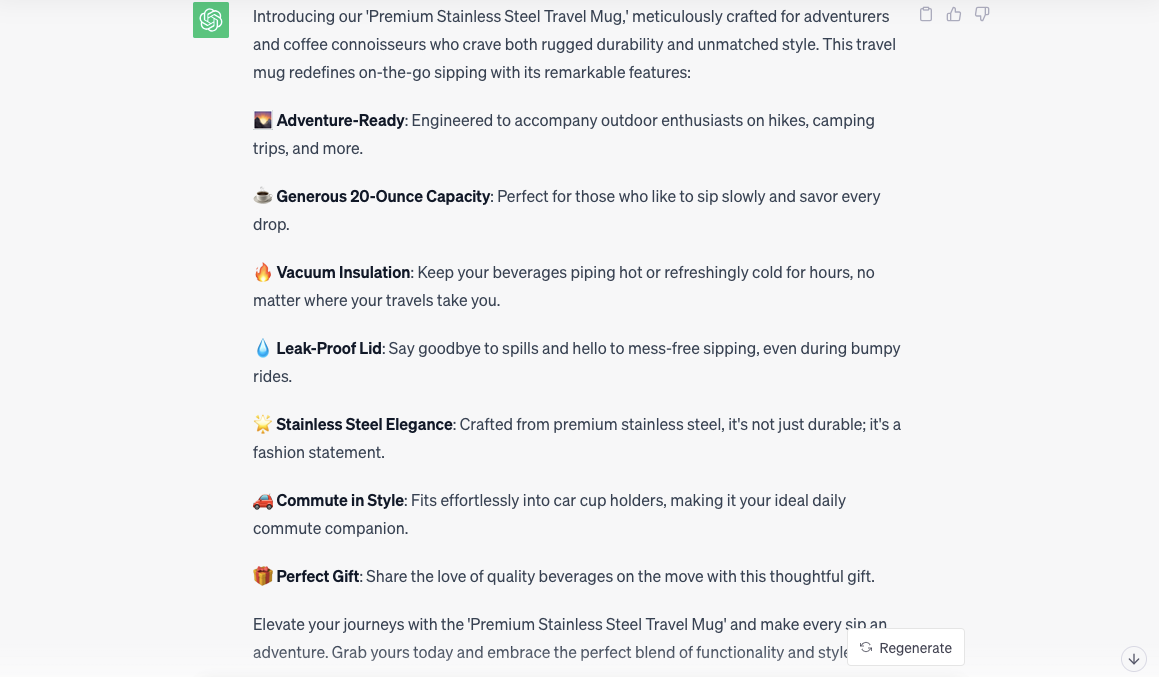
Now you can rewrite, edit, or rearrange the description as per your business needs.
b. How to create social media posts
Begin by specifying the platform for which you want the post (e.g., Facebook, Twitter, Instagram). Each platform has its own style and character limits, so this information is crucial. While providing clear instructions is essential, try to keep the prompt concise and to the point. Avoid unnecessary details that may confuse the model.
Here’s an example of a well-crafted prompt for a social media post:
For our Facebook page, create an engaging post to introduce our latest arrivals in the ‘Trendy Tees’ collection. Include these features:
- Premium 100% cotton
- 180 GSM
- Available in sizes XS to XXL
Maintain a friendly and informative tone, emphasizing the quality and versatility of our Trendy Tees. Include the hashtag #TrendyTeesFashion. Our goal is to captivate our followers’ fashion sense and encourage them to explore our unique collection.
Conclude the post with a compelling Call to Action: ‘Upgrade your wardrobe today with Trendy Tees. Shop now!’ Keep the post length between 100-150 words.
And, here’s the output:
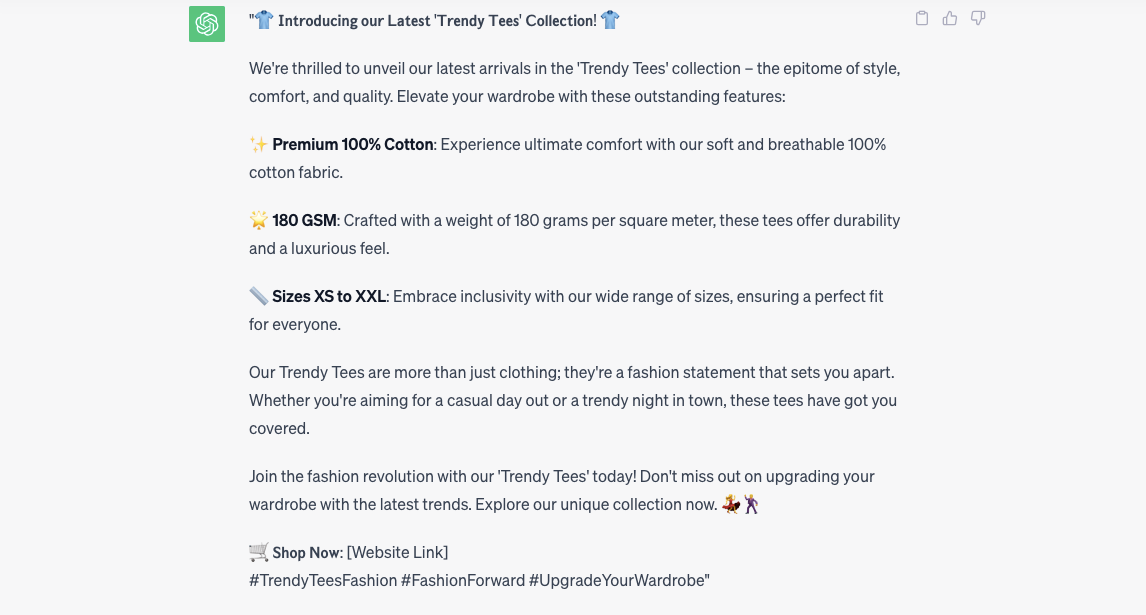
Thus, you can generate social media posts that align with your brand’s goals and engage your audience effectively.
c. How to write email copies
Determine the primary goal of your email. Are you sending a promotional email, a newsletter, a product announcement, or something else? Knowing the purpose helps shape your prompt. You should also consider factors such as demographics, interests, and behavior to tailor the email copy to your audience.
If applicable, incorporate personalization elements, such as the recipient’s name or past interactions with your brand, to make the email more relevant. Emails should be concise and to the point. Avoid lengthy paragraphs and use bullet points or lists for readability.
Here’s an example of a prompt for an email copy:
Generate a promotional email for the upcoming ‘Summer Sale’ campaign of our beauty product brand Go Gorgeous. The email is targeting our subscribers (primarily women aged 25-45) and aims to inform them about the flat 30% sale on all products.
Craft an engaging subject line that emphasizes savings. Include a CTA encouraging readers to ‘Shop Now’ and a personalization element by addressing recipients by their first name.
Maintain a friendly and upbeat tone. Keep the email length concise (around 150-200 words) for easy readability on both desktop and mobile devices.
Now look at the result:
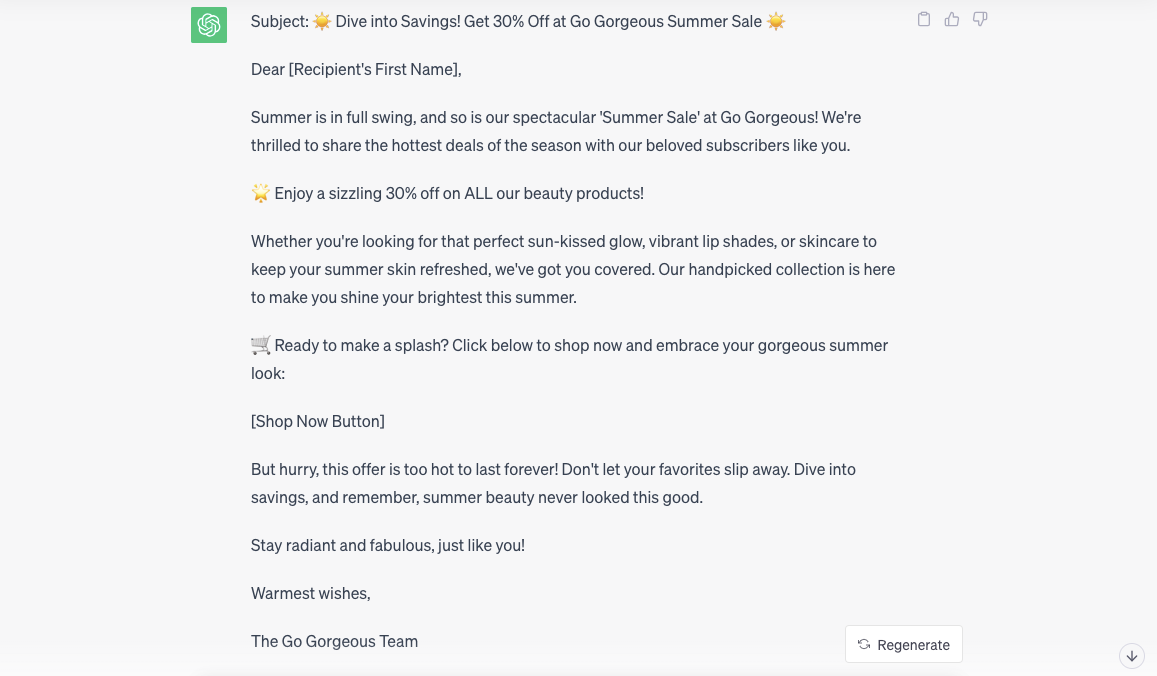
After generating the email copy based on the prompt, review and edit it for coherence, grammar, and alignment with your brand’s voice.
d. How to come up with content ideas
Creating a prompt to generate content ideas effectively involves understanding your content goals, target audience, and the specific topics or themes you want to explore. You need to indicate the types of content you’re interested in generating ideas for. This could include blog posts, infographics, videos, podcasts, or social media posts.
Here’s an example of a prompt for generating blog post ideas in the food and cooking niche:
Generate 10 blog post ideas related to ‘Healthy Meal Prep’ for our cooking blog. Our audience consists of health-conscious individuals looking for easy, nutritious recipes. We prefer a friendly and informative tone. Please focus on topics like ’30-Minute Lunches,’ ‘Plant-Based Dinner Ideas,’ and ‘Kids-Friendly Meal Prep.’ Feel free to incorporate keywords like ‘meal prep,’ ‘healthy recipes,’ and ‘nutritional tips.’
And, here are 10 blog post ideas related to ‘Healthy Meal Prep’ for your cooking blog:
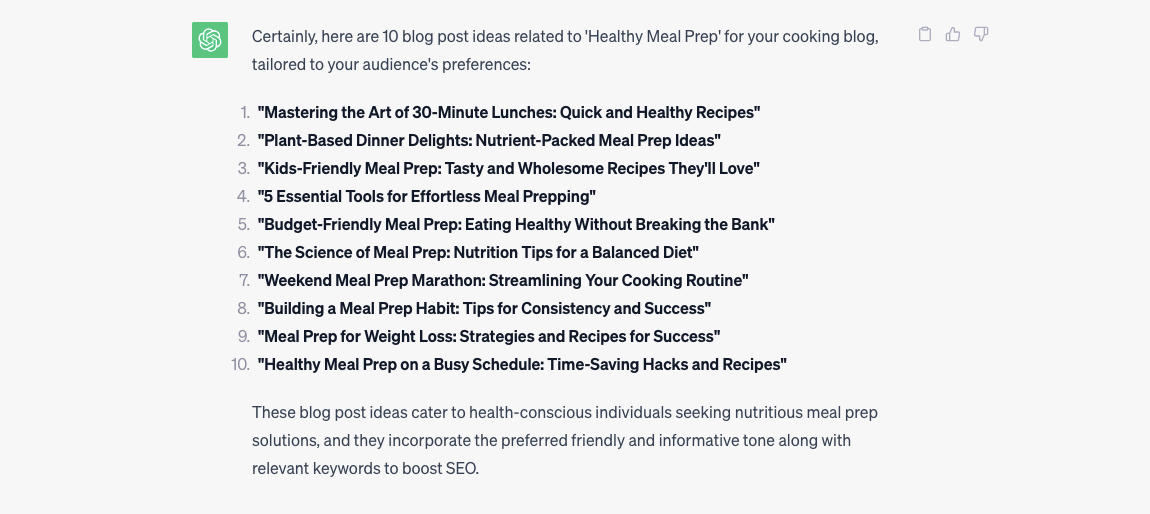
Don’t rely only on ChatGPT for content ideas. You need to research blog topics from multiple aspects. Conduct keyword research to identify the terms and phrases your target audience is searching for. These keywords can help you create content that’s likely to rank well in search results.
e. How to generate engaging titles
You need to understand the content’s purpose, target audience, and the essence of the topic you want to cover. Then, clearly state the subject or theme you want the title to revolve around. Ensure it aligns with your content strategy.
Include relevant keywords in the prompt to optimize titles for search engines (SEO) and enhance discoverability. You can also suggest the inclusion of powerful words or phrases that evoke emotion or urgency.
Here’s a prompt to generate engaging titles for our WordPress blog, WP Hive:
Create compelling blog post titles for WP Hive, our WordPress blog, aimed at WordPress enthusiasts and site owners. We want titles that inform, inspire, and engage our audience in the world of WordPress. Maintain a professional and informative tone. Focus on these topics:
- SEO Strategies
- Latest WordPress Plugin Trends
- WordPress Security
- WordPress for Beginners
- Dokan Multivendor Plugin
Provide two titles for each topic.
Here’s the output generated by ChatGPT:
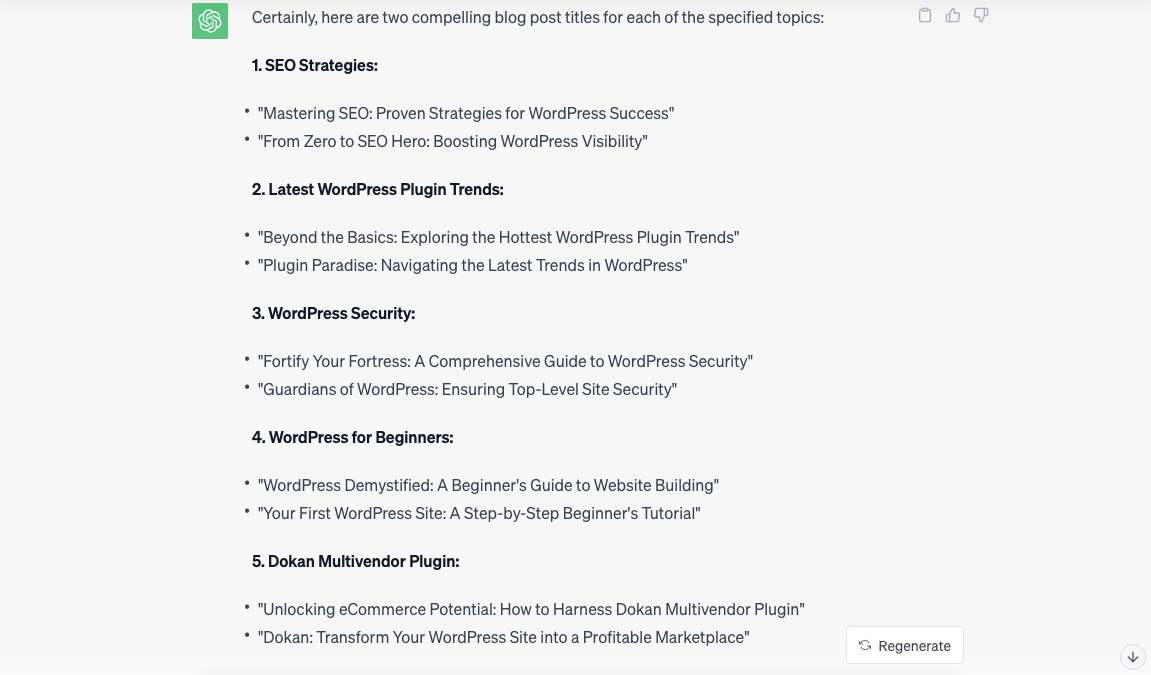
All these suggestions look great. Still, you need a human touch to keep the content easily readable and make it well-optimized for search engines. So, the next step of using ChatGPT prompts for marketing is to complement the content with your creativity.
3. Complement with human-created content
Carefully review the AI-generated content for accuracy, relevance, and alignment with your marketing goals. Make any necessary edits to improve the quality and coherence of the text. While AI-generated content can be efficient, consider complementing it with content created by human writers, especially for creative or emotionally resonant pieces.
More than half of the firms, 56%, saw inaccuracy as a significant risk when using generative AI.
The state of AI in 2023: Generative AI’s breakout year
So, you shouldn’t put the trustworthiness of your business at stake by believing blindly in a generative AI tool like ChatGPT.
4. Conduct A/B testing (if needed)
If you have multiple versions of AI-generated content, conduct A/B testing to determine which performs best with your target audience. Use the winning content in your marketing campaigns.
5. Monitor and analyze performance
After using AI-generated content in your marketing campaigns, monitor its performance. Track key metrics such as engagement, CTR (click-through rates), and conversion rates to assess their effectiveness.
6. Iterate and optimize for better results
Continuously refine your ChatGPT prompts and content generation process based on performance data and customer feedback. Iteration is key to improving results over time.
7. Comply with legal and ethical standards
Familiarize yourself with relevant laws and regulations in your industry and region, including consumer protection laws, data privacy regulations (e.g., GDPR, CCPA), and advertising standards (e.g., FTC guidelines). Ensure that any data used in your marketing efforts, including customer data, is handled in compliance with privacy laws.
Refrain from making false or misleading claims about your products or services. Ensure that any statements made in marketing content are accurate and verifiable. You need to use AI responsibly and ethically to avoid creating content that promotes harm, discrimination, or unethical practices.
But, the question remains: should you use ChatGPT for marketing? We’ll discuss this in the following section.
Should you use ChatGPT for marketing purposes?

Yes, you can use it but depending solely on any AI tool will be considered self-destructive. Using ChatGPT for marketing purposes can be a strategic decision. And, you should use it with careful consideration of your specific goals, resources, and ethical considerations. Here are some factors to weigh when deciding whether to use ChatGPT in your marketing efforts:
Advantages of using ChatGPT for marketing:
- Efficiency: ChatGPT prompts allow you to quickly generate content for various marketing materials, such as blog posts, social media updates, email campaigns, and product descriptions. This efficiency can save you time and resources compared to manual content creation.
- Availability: It can provide 24/7 support. Your customers can engage with your brand at any time, which can enhance customer satisfaction. Moreover, It can handle a high volume of interactions simultaneously, making it suitable for businesses with large customer bases.
- Consistency: ChatGPT delivers consistent messaging, reducing the risk of human error and ensuring that brand messages align across various channels
- Data analysis: ChatGPT can analyze data and provide insights, helping you better understand customer preferences and behavior.
- Content inspiration: You can use ChatGPT prompts as a source of inspiration for your marketing campaigns. It can help you brainstorm ideas and explore new directions for your content.
- Cost-effective: Automating content generation with ChatGPT can reduce the need for hiring additional writers or content creators, potentially leading to cost savings.
- A/B testing: You can use ChatGPT to generate multiple versions of marketing messages and test them to determine which ones resonate most effectively with your target audience.
Challenges and considerations:
- Lack of creativity: ChatGPT doesn’t truly understand the content it generates. It relies on patterns in data and doesn’t possess genuine awareness. This makes it less suitable for creative marketing campaigns that require out-of-the-box thinking. However, it may generate plausible-sounding responses that are factually incorrect or nonsensical.
- Ethical concerns: Misuse of AI-generated content, such as spreading false information or impersonating humans, can harm your brand’s reputation and raise ethical concerns.
- Customer experience: Over-reliance on AI chatbots can diminish customer experience, especially when complex or emotionally sensitive issues require human intervention.
- Content quality: While ChatGPT can generate content, it may not always produce high-quality or persuasive marketing materials, and human editing will be necessary.
- Data privacy: You have to ensure that you handle customer data responsibly and in compliance with data privacy regulations when using ChatGPT for marketing purposes.
- Risk of bias and inappropriate content: ChatGPT can sometimes produce biased or objectionable information from the internet. OpenAI has made efforts to mitigate this, but it’s not foolproof yet.
- Limited domain knowledge: ChatGPT’s knowledge is limited to what it was trained on up to its knowledge cutoff date (September 2021). It may not have information on recent events or specialized domains.
Our verdict on the use of ChatGPT for marketing
ChatGPT can be a valuable tool for automating routine tasks, providing consistent responses, and analyzing data. However, it should be used cautiously, with a clear understanding of its limitations and potential ethical considerations.
Simply put, the use of ChatGPT for marketing purposes can be a double-edged sword. That’s why combining AI-driven solutions with human oversight and creativity is the most effective approach for a successful marketing strategy. Human intervention is a must to maintain trust and authenticity with your audience. So, you can’t write off copywriters and content writers from the marketing game.
CAUTIONS: When should you not use ChatGPT for marketing?

While ChatGPT is a valuable tool for marketing in various contexts, there are situations where its use should be approached with caution or avoided entirely. Here are scenarios where you should be careful or refrain from using ChatGPT for marketing:
1. When you need to maintain a unique brand voice
ChatGPT may not fully grasp the subtleties and uniqueness of your brand’s voice. So, it becomes challenging to create content that authentically represents your brand personality and messaging.
2. When you’re talking about sensitive topics
Sensitive topics require a high degree of empathy, cultural sensitivity, and understanding of the emotional nuances involved. ChatGPT lacks emotional intelligence and may generate content that is insensitive, offensive, or inappropriate.
3. When you’re dealing with legal compliance
Legal compliance demands precise and accurate language. Even minor errors or inaccuracies can have legal consequences. Besides, ChatGPT may not be aware of the local laws you’re referring to. It may produce generic content with legal inaccuracies.
4. When you need short and direct answers
ChatGPT often generates lengthy responses and fails to provide concise and to-the-point answers. Thus, AI-generated content may be less effective in conveying information quickly and efficiently. Even the creator of ChatGPT, OpenAI acknowledges this issue in their announcement blog post:
The model is often excessively verbose and overuses certain phrases. These issues arise from biases in the training data (trainers prefer longer answers that look more comprehensive).
5. When you need recent information and statistics
ChatGPT’s knowledge is based on data available up to its last training cut-off in September 2021. It can’t provide the most up-to-date information or recent statistics. Here’s an example of how ChatGPT fails to impress when it comes to recent information and statistics:
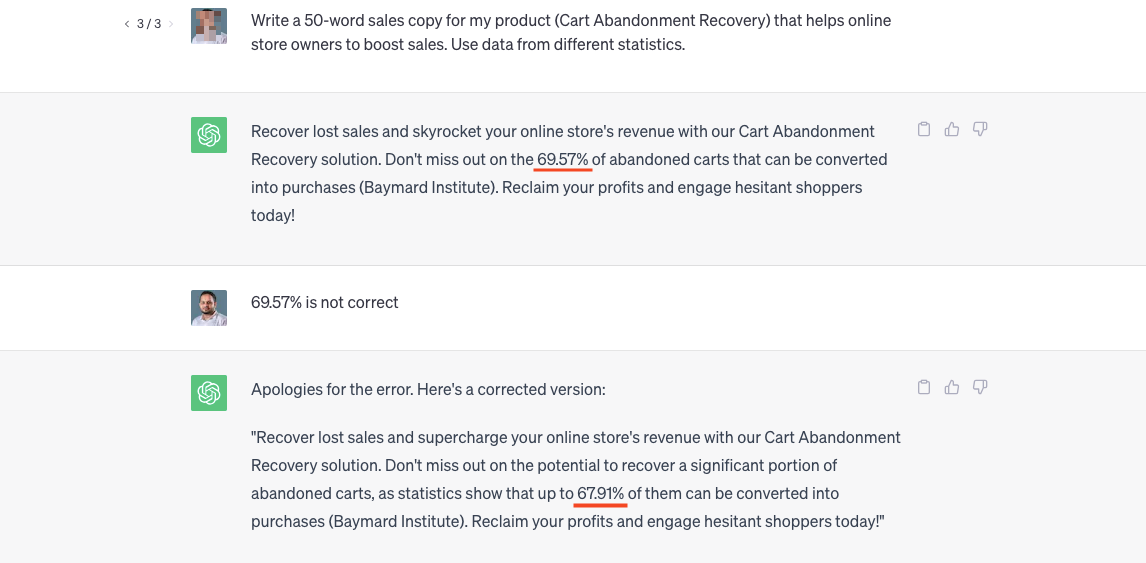
It provided incorrect information twice in a row. According to ChatGPT, the cart abandonment rate is 69.57% or 67.91%. Both are incorrect. The correct answer is shown in the below image.

So, you need to cross-check all data manually when using ChatGPT for marketing.
6. When your position in the SERP matters the most
While ChatGPT can generate content, it may lack the ability to produce content that is genuinely informative, engaging, and valuable to users. Google prioritizes user-friendly and helpful content. Since ChatGPT can sound robotic, human refinement is essential before posting on your site.
Imagine, multiple companies are writing a blog post targeting the same keyword. All of them are using AI tools to generate content. So, they’ll get almost the same output from the tool and the content will lack uniqueness and may be considered plagiarised to some extent.
If you cover the same topic comprehensively, without the use of AI tools, you’re more likely to rank on that keyword. Because your article will automatically be the better one. So, using only ChatGPT is a bad idea when it comes to writing long-form content that is meant to rank on search engines like Google, Bing, Yandex, and more.
7. When you need accurate data for SEO purposes:
SEO optimization relies on accurate and reliable data. ChatGPT doesn’t have direct access to real-time data like search volume, cost-per-click, and keyword difficulty. We recommend using a keyword research tool like Ahrefs, SEMrush, Moz, or Google Keyword Planner to get accurate SEO data.
Use ChatGPT every day, but wisely!
We’re confident that now you know how to use ChatGPT for marketing, when to avoid this, and what to consider when making use of this amazing AI tool.
In every scenario, human oversight, expertise, and judgment are crucial to avoid potential pitfalls, maintain ethical standards, and ensure that your marketing efforts align with your brand’s values and objectives.
The bottom line is – with wisdom and intention, ChatGPT can be your daily ally for creativity, productivity, and knowledge. All you need to do is start with a clear goal, craft precise prompts, and always review and refine the AI-generated content.
Disclosure: WP Hive earns a commission when you buy through partner links. It does not influence the unbiased opinions of our writers. Learn more →
https://wphive.com/tutorials/chatgpt-for-marketing/
Tanvir Faisal
Md. Tanvir Faisal is a Content Writer at WP Hive with over 7 years of experience in Content Writing, Copywriting, Proofreading, and Editing. He specializes in creating helpful content that engages readers, drives social media shares, and improves SEO ranking. In his free time, Tanvir enjoys exploring new cuisines, traveling to unknown places, and spending quality time with his family.




4 replies on “How to Use ChatGPT for Marketing – Learn From 7 Practical Examples”
Find it very resourceful.
Thanks for your appreciation.
Very Useful
Glad to know that you liked our article.